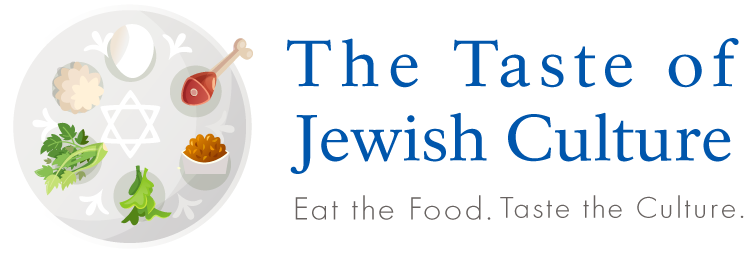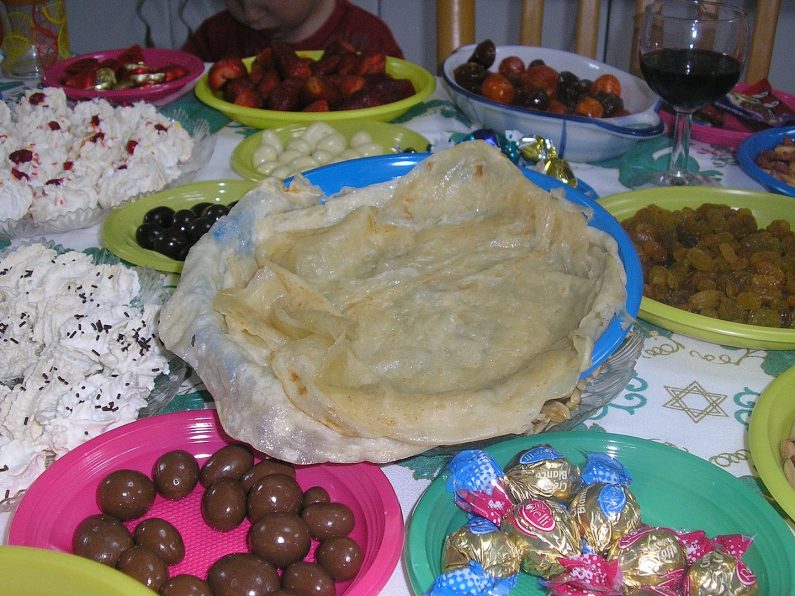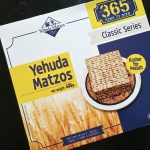Particularly interesting about Jewish Food are the special food-related customs of specific Jewish communities around the world. The Malida ceremony of the Bene Israel Jews around Mumbai, the Ethiopian Beta Israel’s Sigd festival (as they break their fast) and Seudat Yitro (Feast of Jethro) for the Jews of Tunisia are but a few examples.
But even more interesting is when one uncovers the same, or at least similar practices in different Jewish communities from different places. When that happens, the questions that must be answered are whether the customs developed in parallel or traveled from one community to the other, and if the latter, which was the direction of influence.
All of these points come up when we look at Mimouna, the by-now fairly well-known holiday of the Moroccan Jews that immediately follows Passover.
What is Mimouna?
Mimouna, on the surface, simply celebrates the return to eating chametz (leavened dough) and the new beginnings of the Spring season. In Morocco, Muslim neighbors would gift yeast and flour to their Jewish neighbors at the end of the holiday. The Jews would then make a special feast that evening, complete with symbolic decorations, all sorts of sweet foods and especially moufletta.
Not to be confused with the similarly named Italian-America New Orleanian sandwich, muffuletta, Moroccan moufletta is a delicious buttery and honeyed crepe. Made in unique fashion, a crepe is flipped, the next is placed on top of it, then both are flipped together and another placed on top, etc, until you end up with a whole stack of delicious moufletta in your frying pan.
At the Mimouna feast, doors are flung open and all are welcomed into the home. In Morocco, those same Muslim neighbors would usually join the festivities, along with Jewish friends and neighbors. Many see this holiday as embodying the fairly good relations the Jews and non-Jews in Morocco shared for much of history.
The following day, the holiday continues with Jews holding picnics in fields, ideally next to bodies of water. Some had the custom of walking barefoot in the water, and even engaging in a Tashlikh-like ceremony of ridding oneself of sins.
What Does Mimouna Mean?
One of the more perplexing aspects of the Mimouna is the origin of the holiday’s name. Various guesses/folk etymologies have been advanced, including derivations from the Hebrew words Emunah (faith) or Mamon (connected respectively with the future arrival of the Messiah and the Egyptian money believed to have washed ashore after the Red Sea Crossing), or the Arabic Maymun (lucky or auspicious). Another theory connects the name with the father of the Rambam — Rabbi Maimon ben Yosef, of Morocco. I even came across one suggestion the holiday’s name came from a Spanish Easter bread named La Mona, and that Jews asked for Mi Mona — “my Mona” (though I have yet to find another source for this claim).
Perhaps the most convincing theory, however, has been advanced by Israeli historian Yigal Bin-Nun. He points out the similarities between the Mimouna festivities, and those of the Gnawa mystics of Morocco. They have an annual celebration aimed at appeasing Lady Luck — Mimouna (along with her male consort Sidi Mimoun). Among other parallels, he points to similar songs both addressed to “Lady Luck,” not to mention the name of the holiday and the goddess. The additions of such practices as making betrothals and partying with neighbors of other religions may have been glommed on later by Jews as they adopted this pagan practice and adapted it to their own community values and desires.
Mimouna in Israel
Particularly intriguing is the history of the holiday in Israel following the major Moroccan aliyah (immigration) of the 1950s and 1960s. Although the Moroccans comprised the largest single ethnic sub-group of Jews in Israel until the Soviet aliyah in the 1990s, they remained highly marginalized. In Falafel Nation: Cuisine and the Making of National Identity in Israel, Yael Raviv points out that Moroccans were pressured by the hegemonic Eastern European Jews to act more like Ashkenazim than Arabs.
In the early 1970s, the Israeli Black Panthers movement fought for recognition and better treatment of Moroccan (and other non-Ashkenazi) Jews. This gradually led to changes, such as political power and greater societal acceptance, and eventually more cultural pride within these once-abused communities. And with that pride, Mimouna began to grow in popularity in Israel.
Already in Joan Nathan’s 1975 cookbook The Flavor of Jerusalem, we find a description of “Maimouna,” while it was not mentioned in earlier books, such as Molly Lyons Bar-David’s 1964 The Israeli Cook Book. Interestingly, Nathan’s book virtually ignores the nighttime festivities and does not mention moufletta, focusing instead on the picnic/party the following day. It also calls it a celebration mainly for Moroccan Jews alone.
In time, we find Mimouna becoming more widespread in Israel, but here is where we see a major distinction between the original celebration in Morocco and today in Israel. Here, we do not frequently see the gift exchange with Muslim neighbors, and while “outsiders” may still attend the festivities, they are typically Ashkenazim, not local Arabs. Following the strife between Ashkenazim and Moroccan Jews during the 1950s – 1970s, Mimouna has become one attempt at healing the residual wounds and bridging cultural gaps between these groups. For example, a post on Mimouna by the Kiach charitable organization cites multiple “central foundations” of the holiday.
“The first is love between Jews. The meaning of this is a united nation, without categories or classifications: The Jewish people celebrates as a united family.”
While at least one critic claims this is due to an inherent anti-Arab streak in Zionism, I consider this claim baseless and growing out of personal bias. Rather, I’d posit this alteration is simply a recognition of our current situation. Jews and Arabs in Israel, even when on relatively peaceful and civil terms with each other (which is, by the way, the vast majority of the time), are rarely on terms of true friendship. And so bridging that gap in today’s Israeli society is quite challenging, further hindered by each ethnicity’s overall fear of the other.
This doesn’t mean we don’t hope and dream for such coexistence. In that same Kiach post, the other main foundation listed (albeit after the one focusing on Jewish unity) is “love of humankind… understanding of the interdependence and partnership between all people in the world.”
And as Torontonian Moroccan Jew Jimmy Bitton points out, “at no point in history was Morocco an ‘interfaith utopia.'” Jews lived as a minority, often persecuted while also maintaining some fair amount of rights. “Even so,” writes Bitton, “the extent of Jewish integration into Moroccan society is an impressive achievement.”
Mimouna Parallels Around the World
Perhaps the most fascinating aspect of Mimouna (at least to me) is that it is actually not unique among Jewish communities around the world. It is the best known version, and to my knowledge is the only one featuring the delicious moufletta. But there are parallel examples in other places of food-gift exchanges between Jews and their non-Jewish neighbors, along with similar symbol-laden post-Pesach celebrations.
In Pitigliano, Italy, Jews would gift matzah and Passover sweets to their Christian neighbors, with whom they had enjoyed “a long history of peaceful cohabitation and true friendship,” as remembered by Edda Servi Machlin in her book on Italian Jewish Cooking. “When Passover was over, the gentiles reciprocated our gesture of friendship by offering their Easter specialties.” Such exchanges also happened 15th century Huete, Spain, and the Jews made equivalent gifts to their gentile neighbors at Christmas (from Eat and be Satisfied by John Cooper).
More surprising, the gift exchange took place in Jerusalem in the modern period. Cooper highlights Jerusalem Jews sending matzah and jam to their Arab neighbors in exchange for “a copper bowl packed with bread, goats’ butter, and honey.” Back then, Jews and Arabs in the land of Israel got along much better with each other, and even sometimes maintained friendships. Looking at other symbolic foods consumed at the post-Passover feast, Cooper sees the “obvious” connection to Moroccan Mimouna.
Finally, Israeli researcher Esther Shekalim points to the many parallels between Mimouna and a celebration held by Persian Jews after Passover ends [links to an article in Hebrew]. Seeing similar foods (though not moufletta) and many other parallel symbolism (fish, an emphasis on white and green, picnics alongside water sources, etc.) in the Persian Jewish Ruz-e Sal (“New Year”). In this celebration, Shekalim also highlights its roots outside Judaism: Persian Zoroastrianism’s “New Year” Nowruz.
The many analogs here are striking, as are those in Italy, Spain and Jerusalem. Still, Shekalim’s claims go a bit too far, in my opinion. She claims a direct line of influence from Nowruz, through Ruz-e Sal and on to Mimouna, claiming the celebration spread to Morocco with the Arab conquest of North Africa. As proof she points to the holiday names. In Jewish Bavel (Babylonia; medieval Iraq) the name became the Arabic Ras a-Sana (like Rosh HaShanah), while Jews of Syria used a variation of the Persian Nowruz — Nayruz. And in Morocco, she sees the Mimouna/luck connection as being a New Year greeting too.
To my view, the very proof she brings is her claim’s undoing. The similarity between the names used by Jews of other Middle Eastern areas and those of Persia (Iran) is remarkable, though probable and logical. But the fact that the name in Morocco has no real connection to New Year nor to anything Persian, while it does connect with indigenous Moroccan celebrations, underscores how unlikely it is that the holiday spread from Persia to Morocco (in the absence of further evidence). Most likely, the markedly kindred celebrations developed independently (as they did in other countries around the world), and the Moroccan Jews did not “steal” the holiday from the Persians (as the title of Shekalim’s article claims).
Much as we find a mid-winter “festival of lights” among so many religions (both Eastern and Western), without necessarily claiming a direct influence or transmission from one to the next, it is absolutely logical to expect many different communities to develop separate but similar Spring celebrations. And since Passover is also known as Chag HaAviv, the Spring Holiday, combining that celebration with another one focused on returning to eating chametz makes complete sense, wherever you find yourself in the Jewish world.
* * *
My hope for all of us is that we find some way to celebrate Mimouna (by any name you choose) in a few days when Passover ends. Let’s celebrate new beginnings and good fortune, find ways to bridge the gaps between ourselves and our in-some-way-different neighbors (and this year, also with those who are similar to us but have been socially distant), and eat lots of yummy foods.
If you do know any traditional Moroccan Jews, see if they’ll have you over for homemade moufletta. If you aren’t that lucky, find a good recipe online and start piling up the buttery honeyed deliciousness!
(Okay, so this wasn’t a short post, as I expected they all would be, but what else do I have to do with my time these days? 😉 )







What the Dairy-on-Shavuot Custom Says About Jewish Culture - The Taste of Jewish Culture
[…] was what I did when I wrote my post on Mimouna. But in a few of the conversations I had with people after sharing that, I encountered some […]
Caramel Benny
Visiting Morocco was a wonderful journey for me. I encountered a lot of people, discovering food, culture, and definitely the beautiful nature of the country. I highly recommend trying Morocco Tours.
Elodie Memoire
My trip to Morocco was an incredible adventure for me to take. I met a large number of people and learned about the cuisine, culture, and especially the stunning natural scenery of the nation. I can’t say enough good things about Morocco Tours.